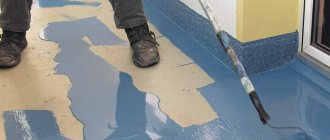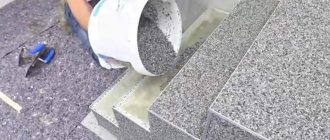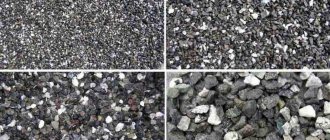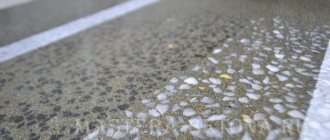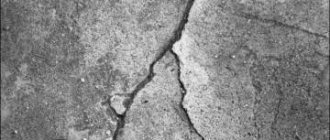Composition of asphalt crumbs
The main components of the material are gravel, crushed stone, sand and bitumen. Concrete may also be present as a binder. The ratio of components depends on the brand of asphalt, the type and condition of the road surface during removal. On average, a crumb includes:
- crushed stone - 25–45%;
- natural and artificial sand - 50–60%;
- bitumen - 3–7%.
The concentration of the latter in crumbs is less than in asphalt - the binding component leaves the coating during the operation of the road, creating the need for its repair.
Specifications
The product is a crushed road surface. It is carried out at the repair site - asphalt paving equipment includes equipment that crushes the road surface. Grinding is carried out after removal. Pieces of asphalt are sent to granulate into crushers.
The result is crumbs 3–5 mm in size, differing, depending on the production method, in the following parameters:
- The concentration of the bitumen component is that there are more binding substances in the crumbs, which are produced on site, than in the removed waste sent for recycling.
- Requirements for operating conditions - material from the road is recommended to be used in summer; it must be heated to activate the bitumen and is suitable for completely replacing the sheet. The product obtained from raw materials delivered to the production site is suitable for cold seasons. Due to the lack of binding components, it is recommended to use it to eliminate local defects.
- Price. A cubic meter of material from a cutter, on average, costs 800–1000 rubles. For a similar volume of crumbs from a crusher they charge 600–800 rubles. The cost depends on the buyer's area of residence, as it includes delivery costs.
The crumbs may include different types of asphalt - this affects the weight and other characteristics of the product. So, the mass is 1 cubic. m of crushed pavement varies between 1.5–2.0 tons. The heaviest is asphalt concrete; mixtures without cement have less weight due to the absence of fine fractions.
Asphalt crumbs: preparation and composition
Asphalt granulate is a recyclable material obtained by recycling old road surfaces. There are two production technologies:
- Worn road surfaces are cut off from the surface during road reconstruction using cold milling (layer-by-layer cutting of the road surface). The result is the so-called crumb from under the cutter.
- The second method: after dismantling, the material is crushed mechanically in a crushing and screening plant (crumb chips). The resulting mixture is scattered into fractions (large, medium, fine). This increases the homogeneity and further stability of the material.
Source ytimg.com
Share
The technological value of the material is determined by the presence of bitumen in it. It envelops the granules of the granular material, which improves the final characteristics of the granulate. The composition may include additions, for example, rubber or cement concrete crumbs.
The resulting asphalt crumb is a mixture of crushed stone, sand, gravel and bitumen; the proportions in each specific case depend on the composition of the original road surface. On average, the mixture contains:
- Sand: up to 50-60%.
- Crushed stone: from 25 to 45%.
- Bitumen: 3-7%. The small amount of bitumen is explained by the fact that during the operation of the road it is lost (during the warm period it melts and is squeezed out of the road surface).
- Sometimes concrete is present in the mixture as an additional binder.
Source samstroy.com
Share
What is asphalt crumb good for?
The material is used by industrial enterprises and individuals. Recyclable materials are included in new asphalt mixtures. Depending on the type of product (cold or hot), the waste coefficient in the new material is 0.25–0.6. That is, the share of crumbs reaches 25–60%.
The material is also used for the following works:
- local repairs - the crumb will reduce the consumption of primary asphalt when filling holes;
- preparing the base of the route;
- covering secondary and country roads with low traffic levels;
- strengthening artificial terrain - recyclable materials can be used to fill the shafts of railway and highway tracks;
- improvement of household and public areas - laying of asphalt crumbs is carried out in parking lots, country roads, sports fields and floors of technical premises.
To work with recyclable materials, you will need equipment capable of compacting and melting the bitumen into the mixture. The last procedure is not necessary - you can lay the crumbs without heat treatment - the binder will bind the particles together during the compaction process.
Technology for laying asphalt chips
The application process depends on the area of application - when strengthening the relief, the mixture is scattered in an even layer (at least 20–30 mm) and leveled with a roller tool. In the case of laying paths, the site is first marked, and soil is excavated inside the contour of the future roadbed. Crumbs are poured into the recess and then compacted. The principle remains the same when creating secondary highways and landscaping the yard.
How to lay asphalt chips with your own hands
First of all, the required volume of raw materials is calculated.
Paths made of asphalt chips in the country will require a depth of 30–40 mm. With a width of 50 cm per 100 m of coverage, you will need 0.15 cubic meters. m of material. Or 0.23–0.3 tons of product, depending on density.
With a Kamaz carrying capacity of 6 tons, one vehicle is enough (almost 2 kilometers worth of raw materials) to mark routes in the yard and fill holes behind the gates.
Work order:
- Marking - a diagram of paths is drawn, which is transferred to the territory of the site.
- Preparing the site - 30-40 mm recesses are dug in the marked contours - the basis of future paths; boards or a concrete window sill can be placed at the bottom of straight sections to strengthen the structure in loose soil. Instead, geotextile bedding can be used.
- Filling the crumbs. If you plan to melt bitumen, you will need a tin barrel and thick gloves. A rake can be used for leveling.
- Tamping. For large jobs, such as priming the road in front of a private house, a miniature skating rink is rented. Decorative and narrow paths inside the yard are compacted manually with a roller tool. Wait at least 24 hours for the material to cool or set before using a new route.
Laying asphalt chips with your own hands is easy. The presented algorithm is also suitable for improving technical premises: a barn or a garage. When creating the basis of a parking space, the weight of the vehicle is taken into account. A parquet SUV will require a thicker floor compared to a passenger model.
Self-laying asphalt chips near the house
The simplest and most affordable method of arranging beautiful paths and parking near the house is asphalting. It uses asphalt chips. Its installation does not require precisely calibrated calculations and lengthy installation, unlike concrete slabs and paving slabs. Even if you are new to construction, laying asphalt near your house will not be difficult. Let's consider the algorithm of actions preceding this operation, as well as the asphalt paving procedure itself.
Work begins with digging a pit. Its depth should take into account all elements: sand cushion, crushed stone and asphalt itself. The end result should be in line with the rest of the area. It is advisable to compact the bottom of the path base with a vibrating plate.
Pour the required amount of crushed stone onto the bottom in an even layer and level it. For a home plot, a layer of 15 cm with a fraction with a diameter of 2-4 cm is sufficient. Larger fractions of 7-20 cm will be required if groundwater comes close to the surface. In this case, the crushed stone will serve as drainage. Do not forget to compact the crushed stone with special vibrating machines and rollers up to 6 times. It is at this stage that slopes are created (0.5 cm per meter of track) where rainwater will flow. Also at this stage decorative elements are laid: fences, posts, curbs, hatches.
The final step is laying the asphalt. They lay it at the rate of 1 ton per 10 square meters. This is enough for pedestrian paths and parking lots near the house with a thickness of 4 cm. Special machines and vibrating plates are used for compaction. If you plan to lay several layers, then bitumen is applied between them for adhesion. Periodically, the laid asphalt is watered with water for better compaction. Correctly completed stages of work will ensure impeccable service of the asphalt pavement for 7-10 years.
This is interesting: Curling iron styling for short hair 2021
Pros and cons of using asphalt crumbs
Reducing the burden on the environment and utilities is one of the main advantages of the material. Lining with recycled materials leads to less use of gravel and bitumen, products from the mining and oil refining industries. The advantages of the decision to lay asphalt chips also include:
- pavement strength - a mixture from the highway will ensure the strength of your home driveway;
- weather resistance;
- aesthetic appearance - combines the external characteristics of gravel and asphalt pavement.
Disadvantages of the product are considered to be color changes caused by weathering on the coating and inconsistent quality. The crumb composition can include different types of asphalt: from the classic mixture to concrete and sand variations. This makes it difficult to determine the final characteristics of the product. Residual traces of spills of oil, acid or other aggressive substances that occurred during the operation of the track can affect the health of users of the track made from recycled materials.
Reviews
Users rate the material positively. Reviews show that recyclable materials are suitable for designing passenger transport routes. Quotes taken from reputable construction forums.
Leonid: “Trucks left ruts on the crumb road, especially in the summer. The material is perfect for passenger cars - we filled it up 5 years ago until we observed any chipping or pushing through.”
Oksana: “We used it to design paths between the beds. There are no complaints - it doesn’t slip, doesn’t retain rainwater, doesn’t crack in the cold and looks neat.”
Mikhail: “We thought about buying crushed stone, but crushed asphalt was almost 2 times cheaper - the highway was being repaired next to the site. It falls asleep and compacts easily; after 2 years there are no complaints.”
Asphalt crumbs are useful recyclable materials. The material is used in various industries and is suitable for landscape design. With its help, durable courtyard paths and public routes with low traffic flow are created.


